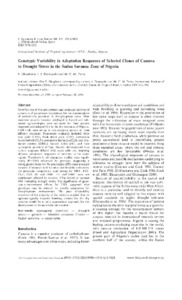| dc.contributor.author | Okogbenin, E. |
| dc.contributor.author | Ekanayake, I.J. |
| dc.contributor.author | Porto, M.C.M. |
| dc.date.accessioned | 2019-12-04T11:23:43Z |
| dc.date.available | 2019-12-04T11:23:43Z |
| dc.date.issued | 2003-12 |
| dc.identifier.citation | Okogbenin, E., Ekanayake, I.J. & Porto, M.C.M. (2003). Genotypic variability in adaptation responses of selected clones of cassava to drought stress in the Sudan savanna zone of Nigeria. Journal of Agronomy and Crop Science, 189(6), 376-389. |
| dc.identifier.issn | 0931-2250 |
| dc.identifier.uri | https://hdl.handle.net/20.500.12478/4126 |
| dc.description.abstract | Identification of drought-tolerant and -resistant varieties of cassava is of paramount importance for the maximization of productivity potential in drought-prone areas. Nine improved cassava varieties developed in humid and subhumid agro-ecologies were evaluated for their growth responses and adaptability in the dry savannas of Nigeria. Field trials were set up in two cropping seasons at three different locations. Parameters evaluated included fresh root yield (FRY), fresh shoot yield (FSY), cumulative leaves formed (CLF), cumulative leaf scars (CLS), root dry-matter content (DMC), harvest index (HI), and root cyanogenic potential (CNp). Results demonstrated that varietal response differed with water table site, implying different adaptation responses of varieties to the water regime. Variations in all characters studied were significantly (P<0.05) influenced by genotype, suggesting a strong genetic basis for the phenotypic differences amongst varieties. Compared with variation attributable to location, the genotypic components were strong for FRY, FSY, CLF, CLS, HI and DMC. HI and DMC were not significantly affected by location. CNp tended to increase with increasing drought stress. The significance of genotype × environment effects for FRY suggested that genotypes may be selected for specific adaptation for drought-prone environments. The poor adaptability responses of the majority of the varieties implied that an agro-ecologically targeted breeding scheme for the dry savanna would be a more appropriate approach for the development of drought-tolerant varieties. |
| dc.description.sponsorship | International Fund for Agricultural Development |
| dc.language.iso | en |
| dc.subject | Drought Stress |
| dc.subject | Growth |
| dc.subject | Manihot Esculenta Crantz |
| dc.subject | Sudan Savanna |
| dc.subject | Water Table |
| dc.title | Genotypic variability in adaptation responses of selected clones of cassava to drought stress in the Sudan savanna zone of Nigeria |
| dc.type | Journal Article |
| dc.type | Journal Article |
| dc.description.version | Peer Review |
| cg.contributor.affiliation | International Institute of Tropical Agriculture |
| cg.coverage.region | Africa |
| cg.coverage.region | West Africa |
| cg.coverage.country | Nigeria |
| cg.isijournal | ISI Journal |
| cg.authorship.types | CGIAR single centre |
| cg.iitasubject | Cassava |
| cg.accessibilitystatus | Limited Access |
| local.dspaceid | 99692 |
| cg.identifier.doi | https://doi.org/10.1046/j.1439-037X.2003.00050.x |

